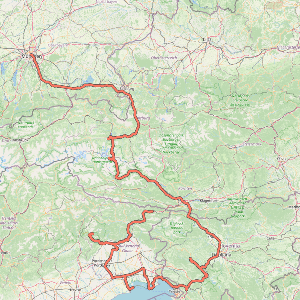Major Excursion: Exploring the Geography of the Eastern Alps
27 Oct 2025
In Germany, Austria, Slovenia and Italy, our students learned about melting glaciers, the legacy of historic mercury mines, and human resilience.
27 Oct 2025
In Germany, Austria, Slovenia and Italy, our students learned about melting glaciers, the legacy of historic mercury mines, and human resilience.

In Munich, the Alps are practically at our doorstep – but during their major excursion through the eastern part of the mountain range, our students discovered the region from entirely new perspectives.
Over the course of 1,500 kilometers and four countries, Dr. Christoph Heinzeller and Daniel Svanidze led the group through Germany, Austria, Slovenia, and Italy. Along the way, they explored the region’s physical geography and experienced first-hand how humans have transformed the eastern Alps from a natural landscape into an intensively cultivated region often threatened by natural hazards.
Highlights
Großglockner, Austria – Melting Glaciers
At Austria’s highest mountain, the students hiked to the country’s largest glacier, the Pasterze. Comparing historical images with today’s landscape showed: climate change is accelerating glacier melt at an unprecedented rate.
Idrija, Slovenia – Legacy of Mercury Mines
The Slovenian town of Idrija is famous for its mercury mines. For more than 500 years, the valuable metal was extracted here – with devastating effects on both the environment and human health. When the last mine closed in the 1970s, the soil, water, and air were heavily contaminated, and many miners had fallen ill or died from mercury poisoning. Interestingly, many of the widows and former miners turned to lacemaking to earn a living – a craft that has become Slovenian cultural heritage.
Grado, Italy – Coastal Protection
By the shores of the Mediterranean, the group learned about the delicate balance of coastal ecosystems. Without protective structures like seawalls and breakwaters, Grado’s coastline would be at serious risk of erosion – threatening not only the beaches but the foundation of the town itself.
Casso, Italy – Building Resilience after Natural Disasters
Sometimes, human attempts to control nature have tragic consequences. When a reservoir near Casso was put into operation in 1963, a massive rockslide triggered a flood wave, destroying large parts of the town Longarone and neighboring communities. Survivors were relocated, and Casso became a ghost town for decades. Today, however, some former residents have returned – and the area has found new life as a rural retreat, attracting visitors and new inhabitants alike.
Through this journey across landscapes, borders, and histories, the students experienced first-hand how natural processes and human interventions intertwine – shaping not only the geography of the Alps, but also the lives of those who call them home.